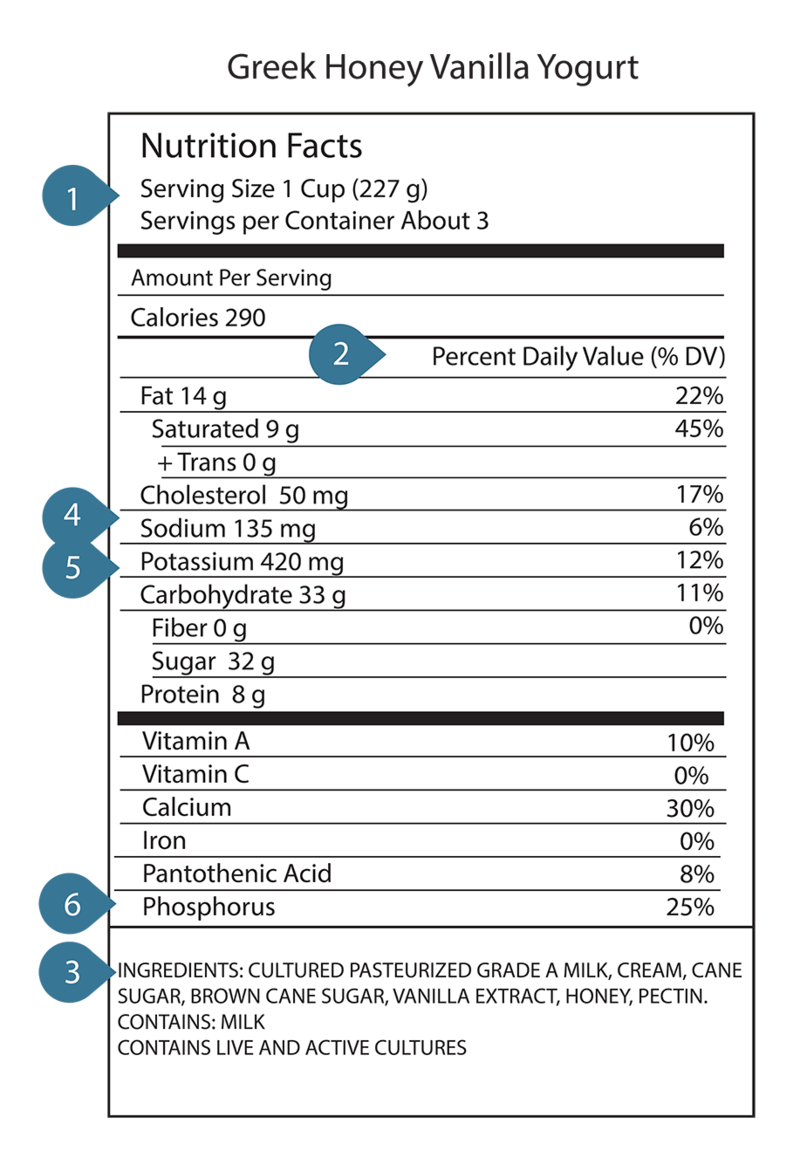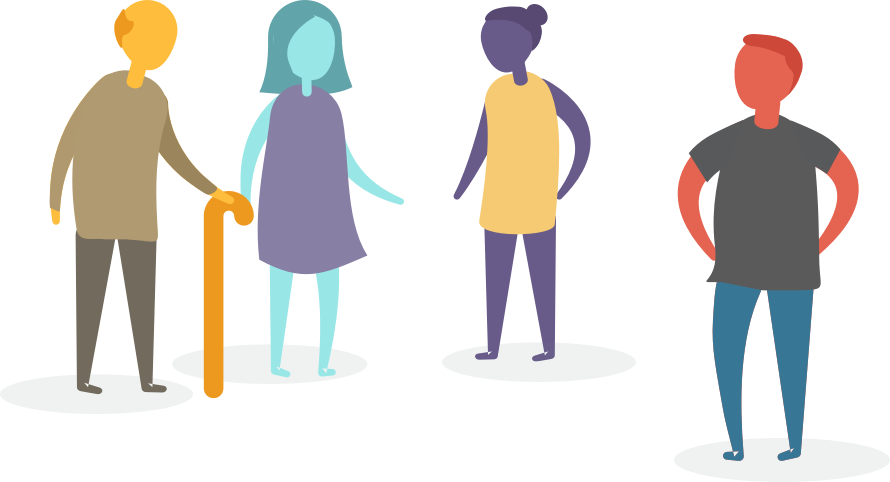Nutrient food label & ingredient list
Learning how to understand and use the nutrition label and read an ingredient list can help you make healthier eating choices. Nutrition labelling is information found on the labels of pre-packaged foods, and gives you information about the nutritional value of a food.
This page will help you identify the amount of nutrients in pre-packaged foods. Pre-packaged foods often list the amount of sodium and carbohydrates in each serving, but they may not list the amount of potassium or phosphorus. To learn more about the amount of nutrients in non-packaged foods (such as meat, grains, fruits, vegetables and dairy), refer to the Common Foods & CKD section of this website.

1. Serving size:
The nutrient information provided on the nutrition label is based on the serving size.
Food packages sometimes contain more than one serving.
It is important to check the amount that you are eating and compare it to the serving size listed on the label. For example, if the serving size says ½ cup and you are eating 1 cup, you need to double the amount of calories, fat, and other nutrients listed.
2. Percent daily value
The percent daily value or %DV is found on the right hand side of the nutrient label. The %DV shows how much of the recommended daily amount of a nutrient is in one serving of that food. 5% DV or lower is considered a little and 15% or higher is considered a lot.
The %DV helps you make informed choices, so you can eat foods that are higher in nutrients you may want (like fiber and vitamins) and lower in the ones you may need to avoid (like sodium). Using %DV can help you balance your diet.
Some nutrients have upper limits that you should try to stay under for your daily intake. Your health care team may have suggested that you limit your sodium, potassium, or phosphorus intake. Every person with CKD has different needs. It is important not to restrict nutrients like potassium or phosphorus unless a health care provider has recommended this to you.
3. Ingredient list
The ingredients are listed under the food label or nutrient facts.
In general, food ingredients are listed in order of their weight, meaning that the first ingredient listed is present in the largest amount (weighs the most) and the ingredient at the end of the list is present in the smallest amount (weighs the least).
You should read ingredient lists to make sure that they do not have any ingredients or nutrients that you are avoiding or restricting in your diet.
4. Sodium (recommended daily intake less than 2300 mg):
Sodium can be found in table salt and processed foods, and naturally occurs in some foods. Your body needs some sodium; however, too much sodium can increase your risk of high blood pressure and can affect your body’s water balance if your kidneys do not work well.
Sodium is often found in food additives or preservatives. Check the ingredient list for any of these sources of sodium:
- Disodium phosphate, sodium alginate, sodium benzoate, sodium gluconate, sodium nitrate, sodium propionate
- Brine
- Monosodium glutamate (MSG)
- Salts such as celery salt, garlic salt, onion salt, table salt, sea salt
- Soy sauce
If you are trying to reduce your sodium intake, try flavouring your food with things like herbs, garlic, onions, spices and lemon and lime juice.
5. Potassium
Potassium helps you maintain healthy blood pressure, and can help your muscles, nerves and heart work properly. You need some potassium for good health, but the right amount of potassium will depend on how your kidneys are functioning. Too much or too little potassium is not good for you.
Many people with CKD do not need to limit potassium. If you are told to limit potassium, the general recommended daily intake is less than 2000 mg. Depending on your individual circumstances, your recommended daily intake might be higher or lower than this.
High amounts of potassium can be found in many foods. The amount of potassium per serving may not be available on the nutrition label. If potassium is not listed on the label, look for words with “Potassium” listed in the ingredient list, such as:
- Potassium chloride
- Potassium lactate
- Potassium phosphate
These additives are commonly found in salt substitutes, such as No Salt® and Half Salt®, deli meats, and processed foods.
Potassium is also found in many whole foods (such as some meats, fruits and vegetables). To learn more about the amount of potassium in these foods, refer to the Common Foods & CKD section of this website.
6. Phosphorus
Phosphorus is a nutrient that helps keep your bones strong. As your CKD progresses you may need to monitor the amount of phosphorus you eat. High levels of phosphorus in your blood may cause calcium to build up in your blood vessels, heart, and joints.
Many people with CKD do not need to limit phosphorus. If you are told to limit phosphorus, the general recommended daily intake is 800-1000mg. Depending on your individual circumstances, your recommended daily intake might be higher or lower than this.
Foods that contain phosphorus additives will often have the words “Phos” written in the ingredient list, such as:
- Phosphate
- Phosphoric acid
- Monocalcium phosphate
- Potassium phosphate
- Sodium phosphate
- Sodium acid pyrophosphate
These additives are commonly found in processed and fast foods, and in dark-colored soda/pop.
Phosphorus is also found in many non-packaged foods and in whole foods (such as meats, grains, nuts and dairy). To learn more about the amount of phosphorus in these foods, refer to the Common Foods & CKD section of this website.
Carbohydrates:
Carbohydrates include sugars, starches and fiber. Your body uses carbohydrates as its main energy source. Sugar and fiber must be listed on the nutrition label, but starch is optional.
Fiber
Fiber is found in many foods such as:
- whole grains
- nuts and seeds
- fruits and vegetables
Fiber is the part of these foods that your body cannot digest. Fiber is important for bowel regularity and to help lower cholesterol levels.
Sugars
Sugars are simple carbohydrates that occur naturally in foods or are added to food for taste.
Naturally occurring sugars are found in fruits, vegetables and milk products. Pay attention to the amount of added sugars. Too much sugar can lead to unhealthy weight gain, which is a risk factor for chronic disease like type 2 diabetes and kidney disease.
If you are limiting your sugar intake look for ingredients that end with “ose”. These are typically added sugars. To locate sugars on an ingredient list look for:
- glucose, fructose, sucrose, dextrose, galactose, maltose, lactose
- ‘syrups’, such as corn syrup
- cane, palm, or coconut sugars
- cane juice (extract or evaporated)
- honey
- molasses
- demerara or turbinado sugar
The information here is an overview of common ingredients and does not cover all ingredients. Speak to a member of your health care team, for example a dietitian, to assist you with your individual needs.
Resources
- Kidney Community Kitchen
Information and tools to help you manage your kidney diet from the Kidney Foundation of Canada.
